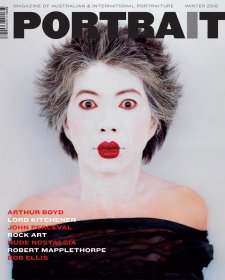In his photographs, artist Robert Mapplethorpe seeks out beauty. His portrait photograph of a boy, Sebastian, promises the elegance of youth, the frame of the boy’s shoulders supported by supple arms. Reflecting on this captured moment, perhaps Sebastian might have later declared: ‘My long limbs, my skin, were unknown to me in my boyhood – I was in them and I couldn’t see them. Their flex and softness were true as nature. I was running and climbing, barely panting, eyes darting to see a bird, foamy sea tickling my armpits and shins’.
Body-building world champion Lisa Lyon is captured as she flexes; her energy is distilled into a cropped image of arm, bicep, shoulder and breast. Her upper-arm muscles are taut as twisted silk sheets, soft as billowing curtains. In the silvery photo her breast is a sun-warmed river-stone. Her collarbone is sculpted rock. The dark curled hair of her armpit is rainforest moss. Mapplethorpe’s photographs evoke the mass of muscle and flesh.
In 1986, sixty of Mapplethorpe’s photographs were shown at the Australian Centre for Contemporary Art in Melbourne. His work had already been bought by the Australian National Gallery, but this was his first Australian exhibition. John Buckley, the curator of the exhibition, remembered him as softly spoken and gentle in jeans and a denim jacket, a quiet young man with a keen eye for ‘precision’. Mapplethorpe’s ‘grace and manners’ calmed the American writer Dominique Dunne’s nervousness when he sat for his portrait in 1988.
When I saw a collection of Mapplethorpe’s photographs spilling from a manila envelope in a Sydney gallery office, I sensed overwhelming intimacy. My work as a curator had afforded direct access to these small black-and-white Polaroid pictures, taken in 1973 and 1974. I gently held in my hand the evidence of what Robert Mapplethorpe had seen, and what he had chosen to preserve: the crumpled white sheets and pillows of an un-made bed, self portraits and pictures of friends. Looking at the small photographs I felt a deep sense of joy. These quiet pictures evoked for me the shivery pleasure of touching warm skin, the closeness of a dear one’s breathing, the tingle of us embracing.
The classical forms of Greek and Roman figure sculpture idealise the beauty and strength of the human body. Greek statues depicted the gods and goddesses of mythology, young athletic victors and scenes from daily life. The power of white marble earned its symbolic purity during the Italian Renaissance. Michelangelo’s towering statue of the youthful biblical David, destined King of Israel and slayer of the Philistine Goliath, replays the naturalism of Classical Greek figure sculpture minus the painted and gilded surface. Like much ancient Greek statuary, Michelangelo’s David was designed to be viewed from below – his scaled-up body and oversized head an intentional counter to perspectival foreshortening. The strength of symmetry, the solidity of musculature and Michelangelo’s artistic touch combine to give David his enduring power.
A photograph of Michelangelo’s sculpted Dying slave was central to a 1976 Mapplethorpe photo-collage, and in 1978 he made photographs of a fragmented bronze sculpture of a man and a marble torso of a woman. ‘If I had been born one hundred or two hundred years ago,’ Mapplethorpe told curator Janet Kardon in 1987, ‘I might have been a sculptor, but photography is a very quick way to see, to make a sculpture.’ The camera was traditionally built on Renaissance principles, says philosopher Arthur Danto. ‘If one aimed at beautification,’ Danto wrote, ‘one was obliged to beautify the object of the photograph, and then record that, which Mapplethorpe did in part with lights and shadows.’
Mapplethorpe would say to his friend Patti Smith, when looking over the frames on contact sheets, ‘that’s the one with the magic’. That magic is manifest in the poise that his pictures relay. They are breathless, floating and evanescent. They are strong, clear and statuesque. The physicality of his portrait photographs is characterised by silkiness; they are satin-smooth. Mapplethorpe said semi-matte photographic paper suited his portraits because ‘they look better on a softer surface’.
In the early 1970s, Mapplethorpe’s good friend John McKendry, curator at New York’s Metropolitan Museum, provided him with private access to the museum’s historical photography collection. ‘Looking at these photographs made me think maybe photography could be art’, observed Mapplethorpe. He was impressed by the palpable physicality, the intimacy and the sensuality of photographs of nudes by Americans Thomas Eakins and Alfred Steiglitz.
Diagnosed with AIDS in 1986, Mapplethorpe died two-and-a-half years later, aged forty-two. During these last years he made portraits of Greek gods and their messengers – Icarus, Hermes, Mercury and Apollo. For several years Mapplethorpe’s minimalist photographs of flowers had been styled for him by Dimitri Levas, and now Levas brought him reproductions of classical statuary. Mapplethorpe had them cleaned to a pristine glow, and he shows the face of Apollo in a close-up profile portrait. Apollo’s lips are gently parted; Mapplethorpe gives him life.
In 1979, the National Gallery of Australia acquired a suite of Mapplethorpe’s delicate photographs of flower still-lifes, and then followed throughout the 1980s with portraits and figure studies, to arrive at a holding of over sixty of his photographs. Eight of these photographs have been selected for the National Portrait Gallery’s forthcoming exhibition, Tough and tender, which presents the work of seven Australian and American artists whose photographic work imbibes sensitivity and beauty. Mapplethorpe’s work is a poignant chord in the exhibition – a song of youthfulness and mortality.















